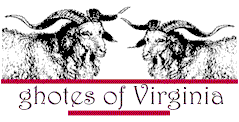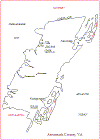
Rev. William Gwynn Coe and the Convention of Accomack
by Carl Robert Coe
 |
Rev. William Gwynn Coe and the Convention of Accomack by Carl Robert Coe |
Rev. William Gwynn Coe and
The Convention of Accomack

On June 8, 1860, the Methodists of Onancock, on the Virginia Eastern Shore, found it necessary because of slavery agitation to dissolve their affiliation with the Methodist Episcopal Church. On January 19, 1861, they "Resolved, That the quarterly conference . . . do hereby notify the presiding elder . . . that we refuse to receive any preacher from the Philadelphia Conference while that Conference remains connected with the Methodist Episcopal Church."
They then invited the ministry and laity of surrounding areas to a convention for the purpose of forming a separate body to be known as the Central Methodist Church. After the convention, held January 29, 1861, they applied for and secured the Reverend William Gwynn Coe as their pastor. Arriving on the Eastern Shore in early April 1861, Pastor Coe joined with these Eastern Shore Methodists and assisted in organizing the Convention of Accomack, an independent church convention consisting of Methodist congregations at Onancock, Drummondtown, Hadlock, Ayers, Ebenezer, and Garrison. Traveling by boat with his family to Onancock, he lived in the parsonage next to Cokesbury Chapel, which at the time was a new church, just seven years old. He preached his first sermon there April 28, 1861, eleven days after Virginia seceded from the Union.
During the war, Coe's secessionist views came to light. Having been raised in a home where slavery was an ordinary and necessary custom, Coe found his sentiments in comfortable surroundings on the Shore, with the exception of occasional harassment by Union soldiers. In June 1861 he called a Day of Fasting and Prayer for the Southern Confederacy, which was conducted at Garrison on the thirteenth of the month. Union officers later arrested him and attempted to secure his signature on an oath of allegiance, known as Special Order No. 49, issued by Union General B. F. Butler, head of the military department at Fort Monroe. With the order Gen. Butler declared, that no man will preach in Drummondtown or elsewhere in this Department unless he has taken the Oath of Allegiance. Coe refused to sign. The officer in charge on the Shore, Colonel Frank J. White, a former New York lawyer, finding Coe steadfast in his refusal to take the oath, placed him under house arrest on several occasions, during which times he was not allowed to preach. One such period lasted from April 30 to May 19, 1863. Finally, Col. White grew weary of Coe's recalcitrance and threatened to have him confined in a Union prison.
The Union Army tightened its grip on the Eastern Shore. One of Coe's children later recalled how a small Federal force sat down on the town, made barracks or stables of the churches, and seemed to find pleasure in vexing all citizens who appeared on the streets. During those difficult times Coe ran the Union blockade of the Shore in a small fishing sloop, usually journeying up the Bay to Baltimore to secure supplies for family and friends. Reflecting on the trips, Coe's son Henry related that the family would wait in great uneasiness until the sloop slipped into port with Rev. Coe and rich supplies of flour, sugar, butter, etc. In 1864 Union "accommodationists" led by George C. Tyler gained control of Cokesbury Chapel and forced Coe out. Tyler, a member of the Chapel, served as the original secretary of the Convention of Accomack when it was formed in 1861. His views slowly changed, and by 1863 he was the leader of a group who favored accommodation with Union forces on the Shore and of returning to the Philadelphia Conference of the Methodist Episcopal Church. That same year Tyler was named tax collector for the Union, and soon afterward was named as one of four civilian supervisors of labor on the Shore. The struggle between Tyler and his party and Coe and his came to a head at the quarterly meeting of the Convention held March 16, 1864. Tyler's forces prevailed and he managed to convince the Cokesbury congregation to rejoin the Philadelphia Conference. The new pastor arrived April 1, 1864, when Pastor Coe wrote in his journal, "Well, well, the Philadelphia preacher is come. Long looked for, come at last! He has come on Fools day, and I am thinking his errand is no better than the day __ and so the result will prove unless I am mistaken."
Coe remained on the Eastern Shore for the next two years as head of the independent convention of Methodist churches. From Cokesbury he moved to Belle Haven and then to a remote farmhouse at Ames Ridge. He continued serving the remaining churches of the young conference and found other preaching opportunities among both Methodist and Baptist congregations. Ayers and Garrison later left the conference, but Coe continued preaching in those areas in school buildings, a Temperance hall, and churches of other denominations, where many were converted and baptized. Establishing a congregation in the old Universalist church in Belle Haven and another in the vicinity of Ayers, the Convention managed to recover from the loss of some of its churches and indeed showed signs of growing. Coe was also preaching regularly at Holmes Presbyterian Church in Bay View, near the southern tip of Northampton County. As soon as the Accomack Convention was back on its feet, the army stepped up its pressure against Coe and his churches. Coe's protests of the Union Army's attempts to suppress his activities eventually led to an all out war between the army and the Independent Convention of Accomack; Col. White ordered all of its churches closed. Pastor Coe and his congregations ignored the order and continued conducting services. Eventually reaching a compromise at a personal meeting with White at Eastville later in 1864, Coe reported the colonel was very polite, and wrote, "My visit to him was on the subject of our Church difficulties. From what he says (and he is now the supreme power here, although I doubt if he is 25 years old), I think our Church will get along without any trouble." Coe fasted that night and prayed that his churches would be spared further harassment. Though Coe never signed the oath, he did somehow manage to convince White of his loyalty to the United States. White, in turn, lifted the order to close the Convention churches and on August 25, 1864, issued Special Order No. 43 which declared:
"The independent Methodist congregations at Belle Haven, Onancock, Hadlocktown, Drummondtown and in the vicinity of Eyres Chapel, and on Ames Ridge, under the charge of Reverend W. G. Coe, having passed resolutions prescribed by Circular from this Office, and having acknowledged themselves loyal, will be permitted to assemble at such times or places as they desire for public worship."
In April 1866 the Independent Convention of Accomack disbanded and rejoined the Baltimore Conference of the Methodist Episcopal Church, South. Though on the Shore for only five years, Coe left a legacy of leadership and steadfastness which was an important source of strength to the Methodists of that area long after the Civil War.
William G. Coe left the Eastern Shore in February 1866. Although his reapplication to the Baltimore Conference was gladly received in March 1863 at their session in Churchville, VA, it was not until he left the Shore that he attended a session of the Conference. His fellow ministers welcomed him back by naming him secretary of the Methodist Annual Conference. He was appointed to the circuit of Front Royal, VA, where he remained until 1867. From Front Royal he went to Shepherdstown, WV, spending three years and building a new church and parsonage, and winning a host of the area inhabitants to the faith.
Carl Robert Coe, The Coe Families of Maryland and Virginia (Columbus, OH: 2002), 1:629-631
 |
 |
 |
| Map of Accomack County | Coe's Out Neck, Guilford, Accomack County |
Muddy Creek, Accomack County Coe's Out Neck in the Background |